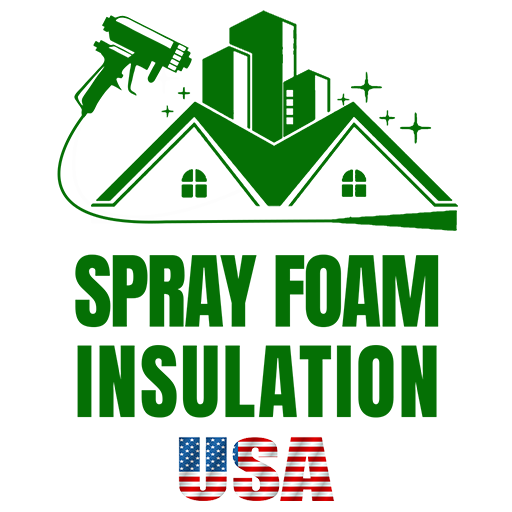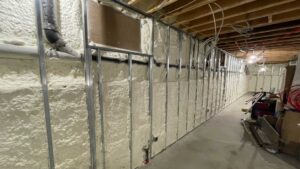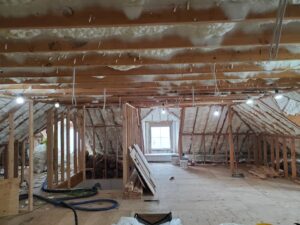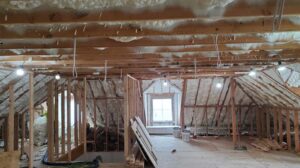Introduction
When it comes to enhancing your home’s comfort and energy efficiency, attic blown insulation is a top choice. Energy efficiency, comfort, and long-term savings are the primary benefits that make attic blown insulation an ideal solution for homeowners in NY and NJ.
Blown insulation in your attic forms a thermal barrier that significantly reduces the exchange of heat through your roof. This means your heating and cooling systems don’t have to work as hard, which can lead to noticeable reductions in your energy bills.
This type of insulation is also excellent for smoothing out temperature fluctuations inside the home, ensuring a comfortable living environment year-round. On top of the immediate benefits, the long-term savings achieved through lower utility bills and less strain on your HVAC system can make attic blown insulation a financially sound investment in your property.

Why Blown-in Insulation is Worth It
Blown-in insulation, often considered a hidden hero in home energy efficiency, provides numerous benefits that make it an attractive option for homeowners. Let’s explore why choosing blown-in insulation for your attic is a wise decision.
Cost-effective
One of the most compelling reasons to choose blown-in insulation is its cost-effectiveness. Compared to other forms of insulation, blown-in options require less labor and fewer materials, which translates into lower installation costs. Homeowners can expect significant savings on their heating and cooling bills. In fact, some users have reported reducing their energy bills by over half during the winter months, as insulation helps maintain a consistent indoor temperature.
Eco-friendly
Blown-in insulation often uses recycled materials, making it an environmentally conscious choice. Cellulose insulation, for example, is primarily made from recycled paper products treated with fire retardants. Opting for blown-in insulation not only helps reduce your carbon footprint but also promotes a sustainable approach by utilizing materials that might otherwise end up in landfills.
Long-term benefits
Investing in blown-in attic insulation delivers long-term advantages for your home. It effectively seals air leaks and fills gaps, creating a tight thermal barrier against heat loss and gain. This comprehensive coverage ensures that your HVAC system doesn’t have to work as hard, extending its lifespan and reducing maintenance costs. Moreover, the enhanced insulation maintains its effectiveness over time, ensuring that your home remains comfortable and energy-efficient for years to come.
Blown-in insulation also contributes to a healthier living environment by reducing the infiltration of outdoor allergens and pollutants. This improvement in indoor air quality is especially beneficial for families with allergies or respiratory issues.
In conclusion, blown-in attic insulation stands out as a cost-effective, eco-friendly, and durable solution that not only saves money but also enhances the comfort and sustainability of your home. Consider how Spray Foam Insulation USA can further enhance these benefits through professional installation and advanced insulation solutions.
Best Types of Blown-in Insulation for Attics
When it comes to maximizing the energy efficiency of your home, selecting the right type of blown-in attic insulation is crucial. Here, we explore the most effective materials available: Cellulose and Fiberglass, and discuss their R-values.
Cellulose Insulation
Cellulose insulation is favored for its environmental benefits and excellent insulating properties. It’s made primarily from recycled paper, treated with fire retardants to enhance safety. Here’s why it stands out:
- Eco-Friendly: Up to 85% of the material is sourced from recycled paper, making it a sustainable choice.
- High R-Value: Offers about R-3.1 to R-3.8 per inch, providing strong resistance to heat flow.
- Fire Resistance: Treated with borates to reduce flammability and increase safety in your home.
Cellulose is particularly effective in attics because it can be densely packed into nooks and crannies, ensuring a comprehensive barrier against heat loss.
Fiberglass Insulation
Fiberglass, another popular choice, is made from fine glass fibers and is available in both batts and loose-fill forms. However, blown-in fiberglass excels in attic applications for several reasons:
- Cost-Effective: Generally less expensive than other forms of insulation, providing a budget-friendly option.
- Versatile R-Values: Fiberglass blown-in insulation offers R-values ranging from R-2.2 to R-4.3 per inch, depending on the installation density.
- Moisture Resistant: Unlike cellulose, fiberglass is less likely to absorb moisture, which can be crucial in humid climates.
Understanding R-Value
The R-value is a measure of insulation’s ability to resist heat flow. The higher the R-value, the better the insulation performance. For attics, a higher R-value is essential because it significantly impacts your home’s temperature regulation and energy efficiency. Here’s what you need to know:
- Ideal R-Value: Depending on your climate, the recommended R-value for attic insulation usually ranges between R-30 and R-60.
- Material Matters: Both cellulose and fiberglass provide good R-values, but the specific installation technique and material density can affect the overall effectiveness.
Choosing the Right Type
Selecting between cellulose and fiberglass largely depends on your specific needs:
- For Maximum Eco-Friendliness: Choose cellulose.
- For Moisture Resistance and Lower Cost: Opt for fiberglass.
- For Best Fit: Consider the shape and accessibility of your attic. Cellulose is better for irregular spaces, while fiberglass works well in more uniform areas.
In conclusion, both cellulose and fiberglass blown-in insulations are excellent choices for attics, each with its strengths. Your decision should be guided by your specific requirements regarding eco-friendliness, cost, moisture resistance, and the structural aspects of your attic.
Moving forward, understanding the installation process will help you better prepare for enhancing your home’s insulation with Spray Foam Insulation USA’s professional services.
Blown vs. Rolled Insulation: Which is Better?
When deciding between blown and rolled insulation for your attic, it’s vital to consider a few key factors: installation ease, coverage ability, and the overall effectiveness in insulation.
Rolled Fiberglass
Rolled fiberglass, often available in batts, is a common choice for DIY enthusiasts because of its straightforward installation process. It’s best suited for areas with uniform spacing between joists, where it can be easily rolled out and cut to fit. Here’s a quick look at rolled fiberglass:
- Easy to handle: Ideal for DIY projects.
- Cost-effective: Generally less expensive than professional blown-in options.
- Effective for uniform spaces: Works well in attics with standard joist spacing.
Blown-in Benefits
Blown-in insulation, whether cellulose or fiberglass, offers several advantages over rolled options, especially in complex attic spaces. Here are the main benefits:
- Superior coverage: Blown-in insulation can fill nooks, crannies, and irregular spaces, ensuring better coverage and fewer air leaks.
- Higher energy efficiency: By filling gaps more completely, blown-in insulation often results in better thermal performance.
- Versatile for various spaces: Effective in attics with irregular or hard-to-reach areas.
Installation Ease
While rolled insulation might seem easier at first glance, blown-in insulation can be more straightforward in the long run, especially for challenging attic layouts. Here’s why:
- Less physical effort: Blowing insulation requires less manual labor compared to fitting and cutting rolls.
- Quick installation: A professional can install blown-in insulation relatively quickly, saving time and potentially reducing labor costs.
- No need for precise cutting: Unlike rolled insulation, blown-in doesn’t require meticulous measurement and cutting, which can simplify the installation process.
Choosing the Right Type
Choosing between blown and rolled insulation often comes down to the specifics of your attic space and your personal preferences for installation:
- Consider your attic’s layout: If your attic has lots of irregular spaces, blown-in insulation might be the better option.
- DIY vs. professional installation: If you’re a confident DIYer, rolled insulation might be appealing. However, for most homeowners, the ease and effectiveness of professional blown-in insulation are worth the investment.
In conclusion, while rolled fiberglass is a viable option for those with simple attic layouts and a strong inclination to DIY, blown-in insulation offers superior coverage and efficiency, particularly in attics with complex geometries or hard-to-reach areas. The ease of installation and long-term energy savings make blown-in insulation a smart choice for many homeowners. Moving forward, understanding the specific costs involved with each type will help in making a well-informed decision that aligns with both budget and insulation needs.
DIY Blown Attic Insulation: Costs and Considerations
When considering adding blown-in insulation to your attic yourself, there are several key points to consider. These include potential DIY savings, equipment rental, and the cost of materials. Let’s break down what you need to know to decide if this is the right approach for you.
DIY Savings
One of the biggest advantages of opting for DIY blown attic insulation is the cost savings. By handling the installation yourself, you can save on the labor costs that professional installers would charge. According to a homeowner on Reddit, their DIY blown-in insulation project reduced their heating bill by over half during the winter months. This demonstrates significant long-term savings on energy costs, which can quickly offset the initial investment in materials and equipment.
Equipment Rental
To properly install blown-in insulation, you’ll need specialized equipment. Typically, this includes an insulation blower, which can often be rented from local home improvement stores. The rental cost can vary but is generally affordable and much less than hiring professionals. It’s important to check with the rental company about the specifics of the machine to ensure it’s suitable for the type of insulation you’re using—whether it’s fiberglass or cellulose.
Material Costs
The cost of insulation material itself can vary depending on the type you choose and the size of your attic. Materials like fiberglass and cellulose are popular choices for blown-in insulation due to their effective thermal resistance and ability to fill irregular spaces. According to research, cellulose insulation is particularly cost-effective and eco-friendly, made from recycled paper products and treated for fire resistance. The material costs will depend on the R-value you aim to achieve and the total square footage of your attic space.
In summary, while the upfront costs of DIY blown attic insulation—such as renting equipment and purchasing materials—need to be considered, the potential savings on labor and long-term energy costs make it an appealing option for many homeowners. Additionally, the satisfaction of enhancing your home’s energy efficiency through your own efforts can be a rewarding experience. Moving forward, it’s crucial to weigh these costs and benefits carefully to ensure that this DIY project aligns with your budget and energy efficiency goals.
Installation Process and What to Expect
When embarking on the journey of installing blown attic insulation, understanding the installation process is crucial. This section will guide you through the necessary steps, techniques, and what you should realistically expect whether you choose to hire professionals or take on a DIY project.
Preparation
Before anything else, preparation is key. Start by ensuring your attic is suitable for blown-in insulation. This involves:
- Inspecting the attic for any existing damages or leaks.
- Sealing any air leaks to prevent energy loss.
- Installing vent chutes to ensure proper attic ventilation, which prevents moisture problems.
These steps are essential to maximize the effectiveness of the insulation and enhance your home’s overall energy efficiency.
Blowing Technique
The technique used to blow in the insulation is crucial for achieving even coverage and optimal insulating performance. Here’s how it’s typically done:
- Using a specialized blowing machine, cellulose or fiberglass insulation is fed into the machine and then blown out through a large hose.
- The person handling the hose will move systematically across the attic, ensuring that the insulation is evenly distributed over the attic floor, covering the entire area to the desired depth.
This process requires a steady hand and an eye for detail to ensure that no areas are left under-insulated.
Coverage
Coverage is critical and must be calculated before beginning the installation. The amount of insulation you need depends on:
- The size of your attic (square footage).
- Desired R-value (thermal resistance), which varies based on your geographic location and the local climate.
- Type of insulation used, as different materials have different insulating properties.
Ensure you have enough material to achieve uniform depth across the entire attic for the best insulating effect.
Professional vs. DIY
Deciding between professional installation and a DIY project involves several considerations:
-
Professional Installation: Guarantees expert handling and precision. Professionals are trained to manage the complexities of attic spaces and have the equipment to distribute the insulation evenly and safely. This option is less risky and is recommended if you are not experienced with home improvement tasks.
-
DIY Installation: Can be more cost-effective and offers a sense of accomplishment. However, it requires renting or purchasing the right equipment and materials. DIY projects demand a significant time investment and a good understanding of the installation process to avoid common pitfalls such as uneven coverage or insufficient insulation thickness.

In summary, installing blown attic insulation can significantly enhance your home’s energy efficiency. Whether you choose to hire professionals or opt for a DIY approach, proper preparation, technique, and coverage are crucial. Each step must be handled with care to ensure that your insulation provides the maximum benefit, keeping your home comfortable and your energy bills lower. Moving on, let’s explore how Spray Foam Insulation USA can further enhance your home comfort and efficiency.
Enhancing Home Comfort and Efficiency with Spray Foam Insulation USA
When it comes to improving your home’s energy efficiency and comfort, Spray Foam Insulation USA stands out as a top choice. This section will dive into how this company can help you achieve a more energy-efficient and comfortable home environment using their expert services.
Why Choose Spray Foam Insulation USA?
Spray Foam Insulation USA offers a comprehensive solution that goes beyond just insulating your attic. They provide a tailored approach to each home, ensuring that every nook and cranny is covered. Here’s why they are a preferred provider:
- Tailored Solutions: Every home is unique, and Spray Foam Insulation USA understands this. They offer customized insulation strategies that are specifically designed to meet the needs of your home.
- High R-Value: Spray foam insulation is known for its high R-value, meaning it provides superior resistance to heat flow. This is crucial for maintaining a comfortable indoor temperature year-round.
- Airtight Seal: One of the standout features of spray foam is its ability to create an airtight seal. This minimizes air leaks, which are a common culprit of energy loss in homes.
- Durability: Spray foam does not settle or degrade over time like some other types of insulation. This means it continues to perform at an optimal level for much longer, providing you with sustained benefits.
- Improved Air Quality: By sealing off leaks and cracks, spray foam helps to reduce the entry of outdoor pollutants and allergens into your home, contributing to a healthier indoor environment.
Real-Life Impact
Many homeowners have experienced significant improvements in their home comfort and energy bills after choosing Spray Foam Insulation USA. For instance, a recent case study highlighted a family who saw their energy bills decrease by approximately 20% after installation. This is a common outcome, as the airtight seal created by spray foam can drastically cut the energy needed to heat and cool a home.
Commitment to Sustainability
Choosing Spray Foam Insulation USA is not only good for your wallet but also for the planet. The company is committed to sustainability, using products that have a lower environmental impact compared to traditional insulation materials.
Expert Installation
The team at Spray Foam Insulation USA is highly skilled and experienced. They ensure that the installation process is smooth and efficient, minimizing any disruption to your daily life. Their professionals are equipped to handle any challenges that might arise during the installation, ensuring that the job is done right the first time.
In conclusion, enhancing your home with Spray Foam Insulation USA not only boosts its energy efficiency but also significantly improves indoor comfort. Their commitment to tailored solutions, combined with the high performance of spray foam insulation, makes them an excellent choice for homeowners looking to upgrade their insulation.
Let’s address some common questions homeowners have about attic blown insulation, ensuring you have all the information you need to make the best decision for your home.
Frequently Asked Questions about Attic Blown Insulation
Is blown in attic insulation worth it?
Cost-effectiveness: Blown in attic insulation is highly cost-effective. It can significantly reduce your heating and cooling bills by improving your home’s thermal efficiency. One homeowner reported that their heating bill dropped by over half during the winter after installing blown insulation.
Budget-friendly: Compared to other insulation types, blown insulation is more affordable upfront. This makes it an accessible option for many homeowners who want to improve their home’s energy efficiency without a hefty initial investment.
Eco-friendly decision: Using materials like cellulose, which is often made from recycled paper, blown in insulation is a greener choice. This type of insulation not only helps lower your energy consumption but also uses materials that are sustainable, reducing waste.
Which blown in insulation is best for attics?
Open-blown cellulose: This is a popular choice due to its effectiveness in reducing energy costs and its environmental benefits. Open-blown cellulose has a good R-value, which measures its resistance to heat flow, making it a strong performer for attic insulation.
Dense pack cellulose: For those concerned about soundproofing, dense pack cellulose can be an excellent option. It offers superior sound insulation properties in addition to its thermal resistance capabilities.
How much does DIY blown attic insulation cost?
DIY costs: If you choose to install blown insulation yourself, the primary costs will be renting the blowing machine and purchasing the insulation material. While this can be more labor-intensive, it is a way to reduce costs if you’re comfortable handling home improvement projects.
Professional charges: Hiring a professional can increase the cost, but it ensures that the insulation is installed correctly and efficiently. Professionals can also help assess your attic to determine the best type of insulation for your specific needs, which can save you money in the long term by optimizing energy efficiency.
Savings comparison: While the initial cost may be higher when hiring professionals, the long-term savings from a properly insulated attic can outweigh these costs. Proper installation ensures maximum effectiveness, which translates into greater energy savings over time.
In summary, blown in attic insulation is a worthwhile investment for many homeowners. It offers a balance of cost-effectiveness, eco-friendliness, and energy efficiency. Whether you decide to DIY or hire a professional, the long-term benefits in terms of reduced energy bills and increased home comfort can be significant.
Conclusion
As we wrap up our discussion on attic insulation, it’s clear that blown in attic insulation stands out as a stellar option for enhancing your home’s energy efficiency and comfort. Here at Spray Foam Insulation USA, we’ve seen how the right insulation can transform a home.
Energy Savings: One of the most compelling benefits of effective attic insulation is the substantial energy savings it offers. By optimizing the thermal barrier of your home, blown in insulation keeps heated or cooled air where it belongs—inside your home. This efficiency reduces the workload on your HVAC system, cutting down your energy bills significantly. Over time, these savings can add up to more than cover the initial investment in insulation.
Home Comfort: Beyond the financial benefits, the comfort of your living environment sees a remarkable improvement with proper attic insulation. It effectively eliminates drafts and hot or cold spots, ensuring a consistent and comfortable temperature throughout your home. This level of comfort not only makes your home more enjoyable but can also contribute to the overall well-being of you and your family. Imagine a home that stays cozy in the winter and cool in the summer, all thanks to the power of effective insulation.
Why Choose Spray Foam Insulation USA? At Spray Foam Insulation USA, we’re not just selling a product; we’re offering a comprehensive solution to make your home as energy-efficient and comfortable as possible. Our expertise in attic insulation, particularly blown in options, positions us as your ideal partner in this journey. We understand that every home is unique, which is why we offer tailored insulation solutions designed to meet your specific needs.
Our commitment to sustainability and quality means you can trust us to provide insulation options that not only save you money but also contribute to a healthier planet. Plus, our team of experts is dedicated to ensuring a smooth and successful installation process, from the initial assessment to the final walkthrough.
Choosing Spray Foam Insulation USA means opting for a partner who values your comfort and energy efficiency as much as you do. We’re here to help guide you through every step of the process, ensuring that your attic insulation project is a resounding success.
Ready to take the next step towards a more energy-efficient and comfortable home? Contact Spray Foam Insulation USA today for a free estimate. Let’s work together to make your home the best it can be.





